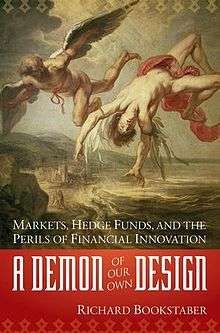A Demon of Our Own Design
 Front cover | |
| Author | Richard Bookstaber |
|---|---|
| Cover artist | The Fall of Icarus by Jacob Peter Gowi Gowy |
| Country | United States |
| Language | English |
| Subject | Risk management, investments |
| Genre | Finance & investments |
| Publisher | John Wiley & Sons |
Publication date | April 2007 |
| Media type | Hardcover |
| Pages | 288 |
| ISBN | 978-0-471-22727-4 |
| OCLC | 73502941 |
| 332.64/524 22 | |
| LC Class | HG4530 .B66 2007 |
A Demon of Our Own Design: Markets, Hedge Funds, and the Perils of Financial Innovation (2007) is a book by veteran Wall Street risk manager Richard Bookstaber.
The theme of the book is that the world financial system is vulnerable to singularities—disasters arising out of apparently trivial details, as implied by chaos theory and its Butterfly effect. He discusses the critical and often underappreciated role of liquidity in the markets and presents a theory of 'normal accidents' arising from the combination of tight coupling and complexity. Bookstaber reviews accidents such as Three Mile Island, ValueJet and Columbia as examples of 'normal accidents' that have corollaries in the financial markets.
The efficient market hypothesis comes under attack in this book using biological and evolutionary analogies. He suggests that overspecialization to an environment leads one vulnerable to change. Therefore, the best adaptive approach is often to have a 'coarse' approach that may ignore fine grained stimuli.
Risk management, however sophisticated it is or can become, won't end this vulnerability. To the contrary, "the more intricate risk-management structures may actually make the system worse."
The dust jacket of the book carries a detail of "The Fall of Icarus," by Jacob Peter Gowy.
Bookstaber had a front-side seat for such crises as the stock market crash of 1987 and the demise of Long-Term Capital Management and his book is built around themes drawn from those experiences.
Table of Contents
- Acknowledgments.
- About the Author.
- CHAPTER 1: Introduction: The Paradox of Market Risk.
- CHAPTER 2: The Demons of ’87.
- CHAPTER 3: A New Sheriff in Town.
- CHAPTER 4: How Salomon Rolled the Dice and Lost.
- CHAPTER 5: They Bought Salomon, Then They Killed It.
- CHAPTER 6: Long-Term Capital Management Rides the Leverage Cycle to Hell.
- CHAPTER 7: Colossus.
- CHAPTER 8: Complexity, Tight Coupling, and Normal Accidents.
- CHAPTER 9: The Brave New World of Hedge Funds.
- CHAPTER 10: Cockroaches and Hedge Funds.
- CHAPTER 11: Hedge Fund Existential.
- Conclusion: Built to Crash?
- Notes.
- Index.
Bookstaber's background
Bookstaber ran the FrontPoint Quantitative Fund. He was the director of risk management at Moore Capital Management, one of the largest hedge funds in the world.
He also worked at Ziff Brothers Investments doing both risk management and running a quantitative equity portfolio. He was the managing director in charge of firm-wide risk management at Salomon Brothers and a member of Salomon's powerful Risk Management Committee. He also designed and marketed derivative instruments, and worked as a proprietary trader, at Morgan Stanley, where he was the firm's first market risk manager.[1]
In addition to A Demon of Our Own Design, he is the author of three other books and scores of articles on finance topics ranging from option theory to risk management. He received a Ph.D. in economics from MIT. His blog http://rick.bookstaber.com/ is an up-to-date commentary on risk management and related investment issues.
Publication Details
- 2007, USA, John Wiley & Sons, ISBN 978-0-471-22727-4, hardcover
- 2008, USA, John Wiley & Sons, ISBN 978-0-470-39375-8, paperback
References
- ↑ Wiley (2009-04-22). "Author Information". Wiley. Retrieved 2009-04-22.